In 1812 the Swiss geographer and scholar, Johannes L. Burckhardt discovered Petra and stood amazed at the magnificence of the Treasury Monument. Since that time thousands of tourists have stood amazed before this monument While it’s facade is very impressive the purpose of this monument has been a puzzle to all those who would seek to understand its use and function.
Since my first visit to Petra in 1979 I too have puzzled over this monument. Since that date I have passed this monument hundreds of times, and almost every time I pause to reflect. While some would propose that the Treasury Monument was a tomb, no tomb inscriptions or grave crypts have been discovered. Others have proposed that it was what the Arabs call it, a ‘Treasury or tax house for passing camel caravans, but archeologists and historians now doubt that many camel caravans came into Petra, as most of the caravans passed the city, traveling on the King’s Highway a good number of miles away.
One thing that is certain, the Treasury Monument was built to impress. It is the first monument that visitors see when they exited the siq, and it is also one of the finest monuments in all of Petra. It is located in such a way that it grabs the attention of every visitor that enters the city, and excites everyone who glimpses it for the first time. Few other monuments in the ancient world were situated in such a way as to inspire and awe with their majesty and mystery.
And so most visitors are caught up with the majesty of the facade. Many are disappointed when they enter the Treasury and discover a simple huge cubical cut out of solid rock, with three small ante-chambers. The ornate facade starkly contrasts the bare walls of the interior. And yet it is here that we must start, for it is here that we will discover the clues that may lead us to unraveling the Mystery of the Monument. Was it a tomb or did it have some other purpose?
The layout of the Treasury Monument is quite simple. As the diagram below illustrates, there are three main chambers: one very large central one, and two smaller ones right and left of the porch.The main central chamber had a rear-back chamber plus two side niches. The chamber to the right of the porch also has a large back niche.

Floor plan of the Treasury Monument. Right: The Main Chamber

It is also important to note that the Treasury Monument was placed high on the side of a cliff. Below it are a number of small tombs and rooms, and before it was a courtyard complete with fountains. This high dominating position added to the impressive nature of the monument. Today the plaza in front of the treasury is filled with flood debris, and tourists can walk directly to the front of the Treasury building. When the Jordanian Ministry of Antiquities removes all of this debris, visitors will once again be able to stand on the plaza floor and look up at the monument, towering above them.
The Notches
There are a number of puzzling elements about the Treasury monument that should be mentioned here. First, on the front of the monument are a series of notches carved to the right and left of the facade. Over the years archeologists and tour guides have suggested a myriad number of uses for these notches. Some have thought that these notches held scaffolding into place, or allowed the original builders to scale the monument. However , when one considers the two ‘unfinished’ monuments in Petra, it is clear that construction workers started at the top of the monument and carved their way downward to the base. This method would provide the builders a continuous platform to stand on as they worked their way downwards.
Another suggestion has been that these notches may have been used to ‘hold’ a finishing plaster onto the face of the monument. While this seems reasonable, it is interesting to note that this feature is not found on other plastered buildings, such as the Great Temple (Royal Courts).
Once the visitor enters the Treasury Monument, another series of notches is evident on the interior. These are placed irregularly around the room, and usually at quite a high altitude. No pattern has been discerned to date. Some have suggested that perhaps there was a second story built around part of the main room in the Treasury, or at least a second story in part of the room. But this is only a guess and nothing concrete is known.
And so it seems that the Treasury Monument refuses to give up its secrets, and its use seems to have been long forgotten.
Other Clues
As I considered the Treasury Monument over the last twenty years, I’ve often wondered about the layout of the rooms in the Treasury. These rooms are unlike any others in the city.
Many of the ancient monuments were used as tombs. Graves, tomb inscriptions, dinning halls, and other evidence give little doubt to their use. This monument, however is very different. In the following sections of this paper, I would like to propose that the Treasury building was actually a library, housing scrolls and parchments. I belive that the central room of the Treasury was the ‘reading room’ and that the side rooms were where the niches where scrolls were kept. First, however, let me cover some background material.
Scrolls
As far back as 3000 BC the Egyptians had learned to manufacture a form of paper known as papyrus. By 1100 BC they began exporting this paper to the Levant and a few centuries later to the Greek world. They exported even more when the Roman Empire was at its height.
Papyrus is relatively simple to produce, and any visitor to Egypt should stop by the Papyrus Museum in Cairo to see it being produced. Thin strips of papyrus stalks as laid side by side and then overlaid with a second layer running the other direction. These are then put into a press, and the adhesive quality of the natural juice of the papyrus plants cements the two lays together to form a sheet of paper. These were commonly 30 - 40 cm long and 11 to 24 cm wide, with 16-18 cm being the normal width. These sheets were then pasted together, often with a four paste, and formed into long rolls. The standard practice was to join twenty sheets together and then to roll them so that they formed scrolls.
If a person wished to write a letter, he simply snipped off a piece of papyrus about the size he desired. If a person wished to write a book, or a longer work, he would need one or more rolls. Long works were often divided up into sections called “books” and labeled.
By the 4th century BC the selling of books had become a flourishing industry. Socrates, in the speech he gave at his trial in 399, remarked that the works of Anaxagoras could be bought for a drachma at the main square in Athens.
The Library of Alexandria
In other papers here on Nabataea.net, researchers have pointed out the close connection that existed between the city of Alexandria and the Nabataean merchants. During the founding of the Nabataean Empire in southern Jordan, Alexandria was at its height. One of the unique features of Alexandria was its museum and its library.
The Library of Alexandria was founded by Ptolemy I, and by the time of Ptolemy III there were two libraries, the major one, and a daughter library located in the sanctuary of the temple to the god Serapis. These were not ‘lending’ libraries as we known them in today, but rather, places where scrolls could be stored and where people could come to study them. Thus, these libraries consisted of large central rooms where scholars could read, and smaller ante-rooms, or even niches where the scrolls were kept.
The scrolls for the library were obtained in a variety of ways. First scrolls were obtained from throughout Egypt. Second, agents flush with money scoured other countries, attempting to buy all the books they could. Older books were preferred on the grounds that they had undergone less copying, and thus would have fewer errors. Soon the industry of forging ‘old’ copies began. The Ptolemies also confiscated any books found on ships unloading in Alexandria, and the owners were given a copy of their book in return. Ptolemy III also went a step farther, and “borrowed” books from Greece. He laid out an enormous amount of money in order to borrow the scrolls. He then had copies made of them, and he sent those back instead of the originals. The Athenians could do nothing but keep the money put up for the original books.
As I considered this fact, I realized that the Nabataeans, ever astute merchants, would have realized the value of books, and they would have been sure to include these books among their items of trade. The Ptolemies were paying out large funds and the Nabataeans must have been eager to provide them with literature.
In the end, the Library in Alexander came to hold 490,000 scrolls, and the daughter library had 42,800 scrolls. The Chief Librarian, Zenodotus devised an alphabetical system of organizing the books, and clerks kept the library in order.
The Libraries of Alexandria existed for several hundred years. While some of the scrolls were burned when Julius Caesar created a diversionary fire on the docks of Alexandria in order to escape a mob, most of the books survived this fire. Didymus, the prolific writer and commentator that used the library for his reference did so in the years after the 48 BC fire. Antony, in the years leading up to the Battle of Actium in 31 BC was rumored to have given 200,000 books to the library of Pergamum. There is also a record of an imperial Roman appointment of a director to the library, and Claudius (AD 41-54) built an addition to it. Later Ptolemies gave the directorship of the library out as a political favor to those they wished to honor. Tiberius Claudius Balbillus served as a director of the library in the middle of the first century AD. The library probably ceased to exist in 270 AD when the emperor Aurelian engaged in bitter fighting in Alexandria, and leveled most of the palace area including, presumably the libraries.
Why have I mentioned this? Because libraries, books, and scrolls would have been of great interest to the Nabataeans, who traveled widely and dealt in all kinds of trading material. Later, when they began to build their own city to impress the surrounding nations with the greatness of their civilization, a library would have been a key building. By placing such a building at the very entrance of the city, visitors from other civilizations would have been duly impressed with the culture of the Nabataeans, and less likely to think of them as barbarians from the desert.
The Growth of Libraries around the Mediterranean
With the coming of the Roman Empire, more libraries came into existence. First, even before the Romans arrived, a library was in service in Antioch, during the height of Antiochus III (222-187 BC). Euphorion, a well known scholar and poet accepted to be its director. Little else is known about this library.
Second, the city of Pergamum contained a library. Percomum was a small village in the north-west corner of Turkey, and Lysimachus, one of Alexander’s generals amassed a small fortune in his stronghold there. When Attalus I (241 - 197 BC) became the ruler he decided to raise the standards of the city by becoming a patron of the arts. Using the riches gathered by Lysimachus, he put together one of the first major art collections of the ancient world. Eumenes II (197 - 160) continued and turned Pergamum into a center of literature and learning by building a library that rivaled Alexandria’s. This library was housed in the temple of Athena, goddess of wisdom.
Eventually rivalry developed between the library in Alexandria and the one in Pergamum. The Ptolemies in Egypt eventually stopped the export of papyrus to Pergamum in order to hinder their development. It is said that the Pergamenes then started writing on skins and leather, and eventually the Roman word for this new writing skin became pergamena (paper) or pergamum, from where we get our word parchment.
Slowly other libraries grew in cities around the Mediterranean. We catch glimpses of them from various artifacts. For instance on the island of Cos, off the western coast of Asia Minor there is an inscription, dating to the beginning of the second century BC that lists men who pledged contributions to their library. There are similar inscription in Athens, Rhodes, and elsewhere. A number of these libraries were house in the same building as the gymnasium, or sports center.
As the Roman Empire spread, the number of libraries around the Mediterranean increased. As the Roman Empire spread by force, libraries were looted and scrolls were brought to Rome. Aemillius Paulis established the first library in Rome in this way. He was followed by Sulla and Lucullus who each also established their own library. Sulla’s library was said to include Aristotle’s great collection. Plutarch tells us that Lucullus collected many well-written books and opened his libraries to everyone to come and read. The historian Cicero recorded how libraries functioned, and how the scrolls were catalogued and stored.
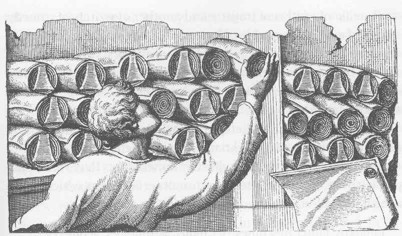
The scrolls were stacked, usually no more than 3 or four high, and each had a tag on the end. (above) One of these tags is clearly illustrated on a wall painting from Pompeii, showing a boy holding a roll. The tag reads “Homerus.” (below)
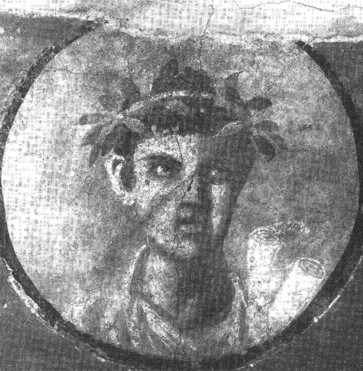
Roman libraries were quite standard in their structure. A library was unearthed at Herculaneum, which was buried when the volcano Vesuvius erupted in 79 AD. Excavation was begun in the eighteenth century and several years later the excavators came across the city library. It was about 3 m by 3 meters, with walls lined with wooden shelves to above eye level. In the center was a free standing wooden bookcase 1.8 meters tall and fitted with shelves on both sides. Every shelf was piled high with papyrus rolls, (around 1,800 in all). This particular library was quite specialized and contained a great number of the works of Philodemus, who lived from 75 to 40 BC. Historians believe that small libraries such as this existed in many Roman towns.
A short time before his assassination in 44 BC, Julius Caesar wanted to enhance Rome’s cultural status, and so he made the decision to build a large public library. Some years later, Asinius Pollio created this library and it became the standard for Roman libraries afterwards.
In 28 BC Augustus repaired a number of public buildings, and among them was the temple of Apollo on the Palatine Hill. Adjoining the temple he erected Rome’s second library, “The Library of the Temple of Apollo” or “The Palatine Library.” This library was divided into large rooms, one for Greek literature and the other for Latin scrolls.
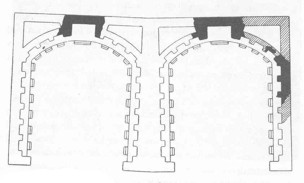
The plan of the Palatine Library with its twin chambers
Within this library were niches in the wall measuring 3.8 m in height, 1.8 meters wide and .6 meters in depth. The scrolls were placed in these niches as well as in book cases in the center of the room. The niches were located high on the wall, and historians have surmised that a portable set of steps must have been used.
Another Roman library was the twin libraries of the Forum of Trajan in Rome. In the center was a forum or plaza where readers could take the scrolls outside into sunlight. The chambers were 27 meters by 20 meters, and two stories high, covered by a vaulted roof. On either side were upper and lower levels of niches for bookcases, two per level. A staircase at the back of the building provided access to the gallery. The niches were 1.6 meters wide and .6 meters deep. The capacity of this library has been estimated at over 10,000 scrolls. The important feature of this library was the large central room where books could be studied.

Plan of the Tarajan Library, with one library to the top and one to the bottom.
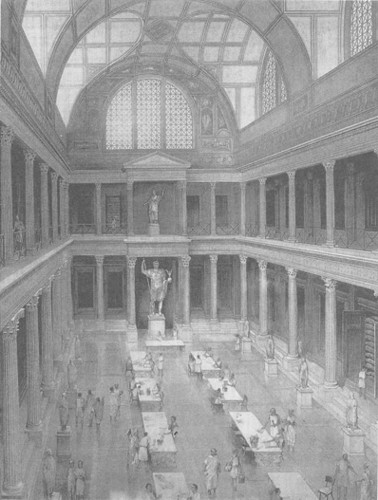
Inside the Library, the central room was used for study, while the books were kept in niches in the walls.
It is interesting to notice that Greek libraries contained stacks of scrolls in close quarters. Roman libraries were designed for readers. They had spacious handsome surroundings, courtyards, and a large central room. The scrolls were nearby, but out of the way. Similar libraries were built at the Baths of Trajan and the Baths of Caracalla in Rome.
Outside of Rome, cities that wanted to enhance their cultural status began to built libraries. In Athens the Library of Hadrian was constructed, with a large courtyard complete with gardens. (below)
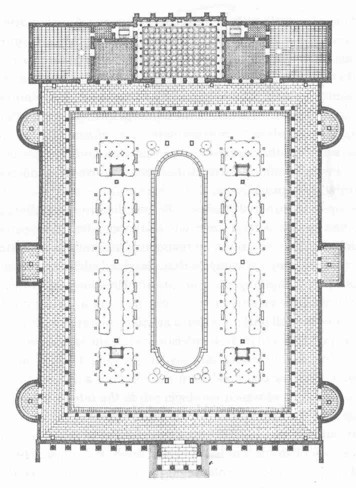
The Library of Hadrian
Carthage in Tunisia and Timgad (Thamugadi) in Algeria also boasted libraries. The plan of the Library at Timgard (3rd century AD) is shown below.
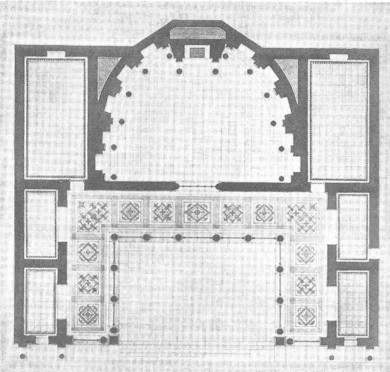
The Library in Ephesus
The city of Ephesus in Asia Minor was also home to a library. Archeologists have been able to reconstruct this building almost in its entirety, and visitors today can see a nearly intact Roman library. This is the library that we want to draw our attention to next as it has several features that parallel the Treasury Monument in Petra.
First, the library in Ephesus was built around a central room 16.7 meters wide and 11 meters deep. Along the sides were niches for books, and balconies set on pillars. The builder of this library was Tiberius Julius Aquila Polemaeanus, who died before the library was completed. Tiberius was then buried in a monumental sarcophagus in an underground chamber.

Ground plan of Ephesus Library
The outstanding feature of the library in Ephesus is its facade adorned with columns, prominent aedicula and a number of statues. When looking at this facade, one wonders if the builders of the Treasury Monument had not visited this site before embarking on the design of the Treasury.
The Treasury Monument in Petra
As is mentioned in other papers on this website, it seems that almost every Nabataean could read and write. Nabataean graffiti has been found all over Nabataea, with inscriptions being left by many kinds of people, including soldiers, farmers, hunters, and shepherds. There is no doubt in the minds of most historians that the Nabataeans were an unusually literate society. Yet, archeologists have not yet been able to find their libraries or collections of their writtings.
Floor Design of the Main Hall
The Treasury Monument contains one large central room 12 meters x 12 meters with 3 very small side rooms According to the Roman style of libraries the central room of the Petra Library would have contained tables and couches where scrolls could be read. The morning sun shines directly onto the Library, and with the doors wide open, the central room would have been quite well lit. There may also have been bookcases along some walls, as the notches in the walls indicate.
But where are the niches that contained the scrolls?
I believe that the Nabataeans combined features of the Greek libraries as well as the Roman ones. Thus the three small side rooms would have been used for the storage of the scrolls or books. These rooms would have been more air-tight and would have preserved the books better than if they were exposed to the elements in the central room. In front of the Petra Library would have been a courtyard or plaza where readers could browse scrolls in the sunlight.
The Treasury Monument was outfitted with huge doors. These doors are very tall and seemed to be designed to let sunlight into the main room. The standard business hours in the Greek and Roman world were from sunrise to about midday. An inscription found in the library of Pantainos reads “Open from the first hour to the sixth” Interestingly enough, it is during this time period that the sun shines onto the Treasury Monument, illuminating the central chamber.
To the right and left of the main doors were two small rooms, each appearing to be some sort of storage room, perhaps for more scrolls.
Over time, the Library was destroyed either by looting, or by the occupants taking their scrolls elsewhere.
Also, it is interesting to compare the type of facade that was used on the Ephesus library with the facade used on the Treasury Monument. One can easily imagine that the designers of the Petra Library had the Ephesus Library in mind when they designed the Treasury Facade.
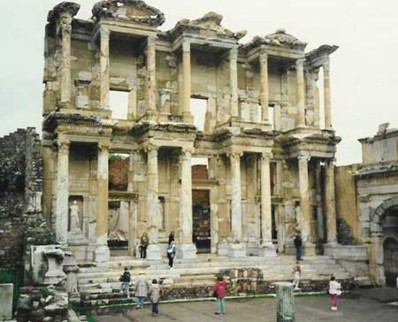
The Ephesus Library. Image copyrighted by Historylink101.com & found at Greek Picture Gallery.

The Treasury Monument
Why a Library?
As we have mentioned in this paper, libraries were often built to enhance and demonstrate the cultural achievements of a city. As the Nabataeans sought to impress on others the honor that their society should have, it should not surprise us that they built one or more libraries along side of their temples and theater. (See Honor and Shame in a Middle Eastern Setting, and The Price of Honor)
The presence of a library would help us understand how Petra would be mentioned as a place of thinking, and later as a center for the operation of the church. The church writer Eusebius spoke out against the theologians of Petra, and later in the mid-4th century, Bishop Asterius of Petra was named as one of the participants who would debate the Arian controversy. Likewise, the theologian Nestorius, (one of the promoters of the Nestorian heresy, which was condemned at the Council of Ephesus in 431) used Petra as his base of operation, and a place where he wrote from. All of this points to Petra as being a center of thought and theology, and thus a good candidate for housing a library.
Conclusion
And so I would like to propose that the Treasury building may have been a library, housing scrolls and parchments. The central room of the Treasury would have been the ‘reading room’ after the Roman style of library architecture. The three small side rooms would have been the niches where scrolls were kept, after the Greek style of library architecture. As I pointed out there are many other elements of the Treasury Monument that are similar to other libraries that were in existence at the time. Along with this, the presence of a library in the city would have increased it’s cultural status and would have helped (perhaps was necessary) in order for the city to gain the title ‘metropolis’ under Emperor Trajan. Was the Treasury Monument really the Library of Petra? Unfortunately we may never know. However, as the Jordanian Ministry of Antiquities excavates the plaza in front of the Treasury, new light may soon be shed on it’s use.
Bibliography
Bickerman, E., Chronology of the Ancient World, Ithaca, 1980
Birt, T., Die Buchrolle in der Kunst, Leipzig, 1907
Blum, R., Kallimachos, The Alexandrian Library and the Beginnings of Bibliography, Trans, H. Wellisch, Madison, 1991
Browning, Iain, Petra, Chatto & Windus, London, 1985
Builetin de Correspondance Hellenique, 59, pages 421 - 425, 1935
Callmer, c., Antiken Bibliotheken, Skrifter utgivna av Svenska Institutet I Rom 10, Opuscula Archaeologica 3, Lund, 1944
Casson, Lionel, Libraries in the Ancient World, Yale University Press, 2001
Deiss, J., Herculaneum: Italy’s Buried Treasure, New York, 1966
Fraser, P., Ptolemaic Alexandria, Oxford, 1972
Gibson, Dan, The Nabataeans, Builders of Petra, Xlibris, Philadelphia, 2004
Harris, W., Ancient Literacy, Cambridge, 1989
Lewis, N, Papyrus in Classical Antiquity: A Supplement, Papyrologica Bruxellensia 23, Brussels, 1989
Lewis, N, Greeks in Ptolemaic Egypt, Oxford University Press, Oxford, 1986
Marrou, H., (Trans. G. Lamb) A History of Education in Antiquity, London, 1956
Mau, A., (Trans F. Kelsey) Pompeii: Its Life and Art, New York, 1899
Nash, E., Pictorial Dictionary of Ancient Rome, New York, 1968
Packer, James, The Forum of Trajan in Rome, Berkley, 1997
Pfeiffer, H., Library at Timgad, Memoirs of the American Academy in Rome, 9, 1931
Pfeiffer, R., The History of Classical Scholarship, Oxford, 1968
Pliny the Elder, Historia Naturalis, various sections
Rostovtzeff, M., The Social and Economic History of the Hellenistic World, Oxford, 1941
Strabo, various sections
Starr, R., Book Trade in Imperial Times, in Clasical Quarterly, 37 (1987)
Syme, R., The Roman Revolution, Oxford, 1939
Tarn, W., and Griffith, G., Hellenistic Civilization, London, 1952
Wycherley, R., Agora, Princeton, 1957
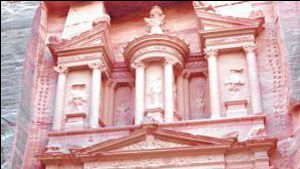
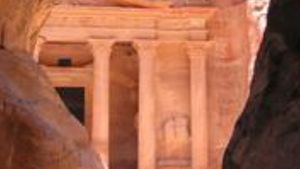
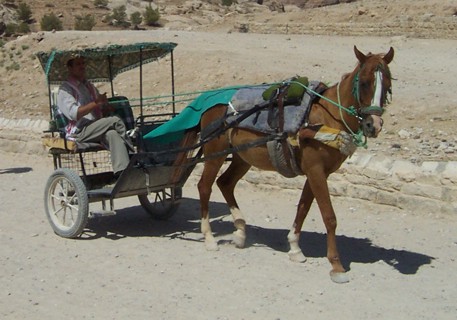
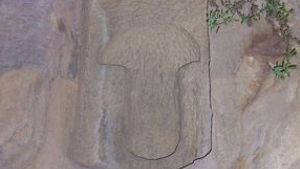
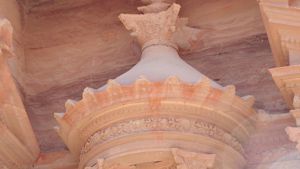

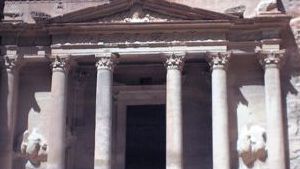
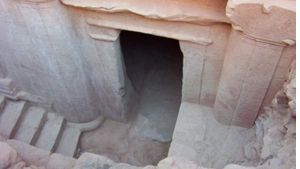
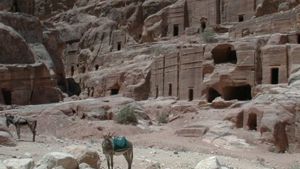

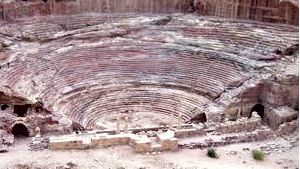

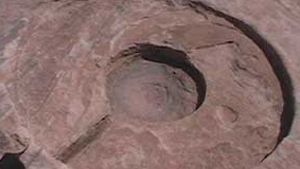
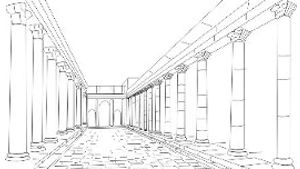

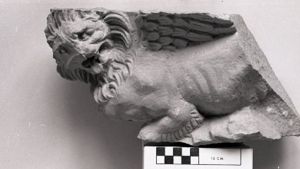

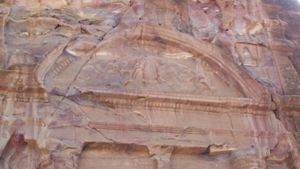
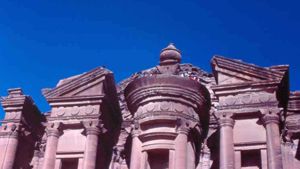
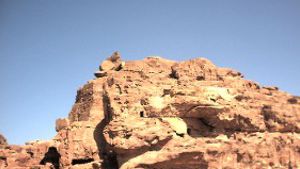
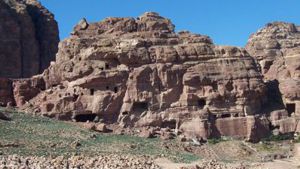
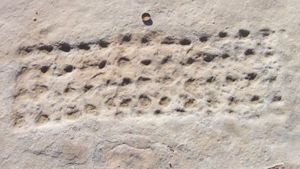
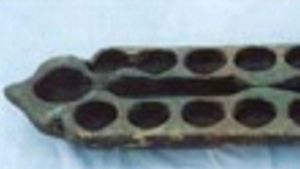

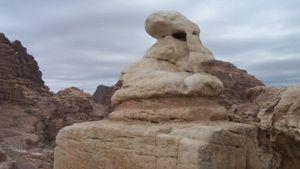
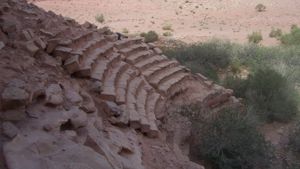
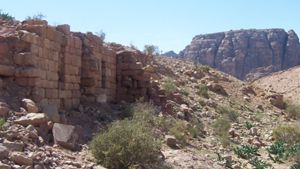

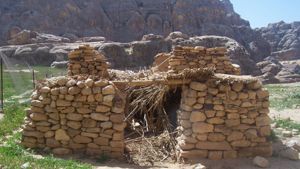

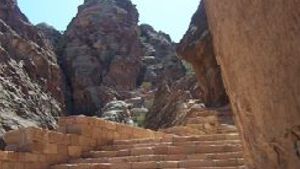


Page Discussion
Membership is required to comment. Membership is free of charge and available to everyone over the age of 16. Just click SignUp, or make a comment below. You will need a user name and a password. The system will automatically send a code to your email address. It should arrive in a few minutes. Enter the code, and you are finished.
Members who post adverts or use inappropriate language or make disrespectful comments will have their membership removed and be barred from the site. By becoming a member you agree to our Terms of Use and our Privacy, Cookies & Ad Policies. Remember that we will never, under any circumstances, sell or give your email address or private information to anyone unless required by law. Please keep your comments on topic. Thanks!